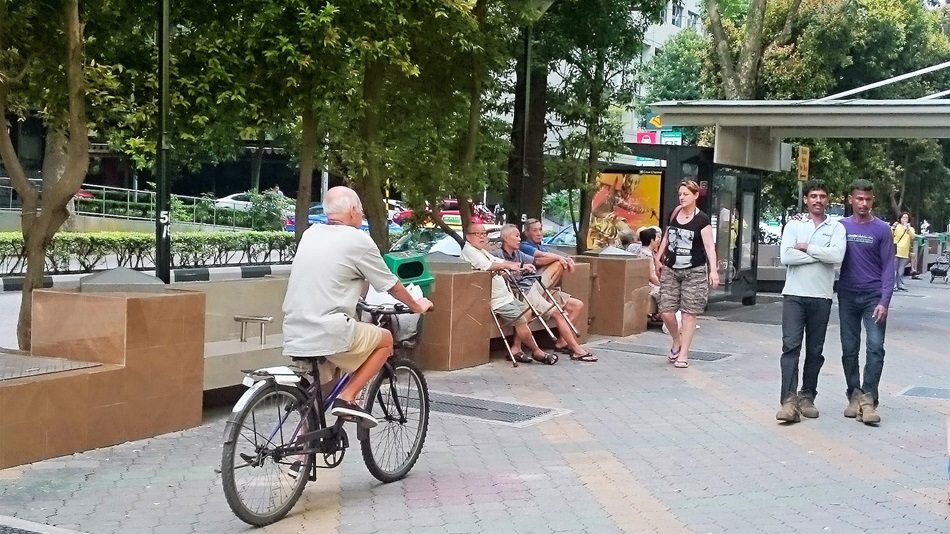Many cities today are saddled with high car dependency, wider roads, fewer pedestrian-friendly streets, increased pollution and inevitably, low walking rates. Congestion is a common sight and this has affected liveability.
Policymakers and planners around the world recognise the growing demand for more liveable cities. The focus however has been on developing public transport. That is only one aspect of making a city liveable – the other is to create an environment that is conducive for walking.
As I look out my office window in Tanjong Pagar, Singapore, I see a lovely patchwork of small, walkable streets, food stalls, and urban architecture. More importantly, I see people walking on the streets, enjoying the scenery and resting under the shade of one of the many trees in this garden city. It truly demonstrates what can be achieved when policymakers design cities with people at the heart.

At the World Cities Summit Mayors Forum and Young Leaders Symposium in Suzhou last year, I shared three key principles on developing more liveable environments by creating more walking opportunities.
From our partners:
Firstly, urban planning and design must begin with the people’s point of view
From this perspective, we need to think about the broad considerations to make the environment more conducive for walking such as safety, convenience, and accessibility. For example, an obvious safety consideration is whether the paths are well-lit at night. And when we think about walking in a climate like Singapore’s, are these paths sheltered from the elements?

Above all, the walking experience should be enjoyable and for this, it is important to design the journey to include pleasant spaces, beautiful streets and green corridors. In rejuvenating the historic Civic District, Singapore’s Urban Redevelopment Authority (URA) successfully created new experiences for the people by designing environments and precincts that brought people closer to water.
Second, shift mindsets to favour walking
In Singapore, nationwide campaigns like the Health Promotion Board’s (HPB) National Steps Challenge are encouraging Singaporeans to walk more and lead active lifestyles. More than 350,000 adult Singaporeans participated in the second edition of the challenge which concluded in April this year, clocking a daily average of more than 10,000 steps.
Design consultants can work with the Singapore government to create more opportunities to walk. Arup, for example, improved pedestrianisation in the Civic District by creating ‘shared zones’ where pedestrians, cyclists, and motorised traffic share the same road space. Carriageways along Connaught Drive were reduced for vehicular traffic, freeing up space for pedestrians.

Singapore’s renowned shopping belt, Orchard Road offers another opportunity to increase walkability. With reduced roads and fitted with the right public infrastructure, Orchard Road could become ‘Orchard Street’. The reduced roads could cater to select vehicular traffic such as buses, taxis, and bicycles only, resulting in more space for walking at leisure and facilitating community events to engage consumers.
Lastly, be flexible in planning
To encourage Singaporeans to use public transport and get moving, the government has implemented several initiatives to ensure it is convenient to reach a train station or a bus interchange from home and work. These are known as first-and-last-mile connectivity (FLMC) initiatives and they include the use of bicycle, personal mobility devices (PMDs) and of course, walking.
During this year’s Committee of Supply Debate, the city-state’s Senior Minister of State for Transport and Health Dr Lam Pin Min shared that space allocation for pedestrians, cyclists and PMD users will be prioritised in town planning.
This demonstrates the rigour that goes into planning an environment that encourages people to stretch their legs. But rigour needs to be complemented with flexibility to accommodate disruptions.

For example, plans to launch a government-led bike-sharing scheme last year were quickly re-assessed to instead support existing start-ups that were already on the ground rolling out bike-sharing services. The focus is now on resolving teething infrastructure issues such as the provision of bicycle stands to encourage uptake of cycling. This will in turn encourage more people to walk, according to city planning expert Jeff Speck who highlighted that the world’s most walkable cities are also among the most pro-cycling.
These three principles are general enough to work for every city and they bring significant economic benefits. Our research shows that there is a clear correlation between cities with more actively mobile citizens and lower healthcare costs. These cities also have lower congestion costs. A separate study by Transport for London indicated that pedestrians contribute 65 per cent more to the retail economy. Hence it is in the government’s advantage to promote walking – and other forms of active mobility – in order to foster the local economy and create job opportunities.
To achieve these benefits, collaboration between government agencies needs to be closer. Many developing cities still lack a framework to initiate discussion among multiple agencies. A good start would be to first dedicate resources for coordination. For example, Singapore’s Land Transport Authority (LTA) conceived an active mobility team whose inputs feed into the URA’s and Building and Construction Authority’s (BCA) masterplans on planning and designing streets for pedestrians, cyclists and PMD users among others. The fact the government has recognised the importance of active mobility and is employing people specifically to drive that agenda is a huge leap in the right direction.
Long-term planning is also key. We need to think beyond rather than playing catch up – plan for 2050 instead of 2020. With cities in the tropics, like Singapore, getting warmer, we need to build more walkable, more sustainable environments. This will inevitably create more liveable and attractive cities, changing the lives of citizens and those of future generations for the better, forever.
This feature is written by Chintan Raveshia & originally appeared in Arup.
















